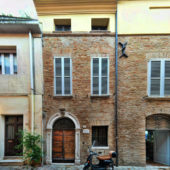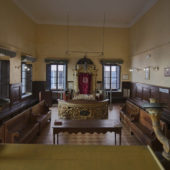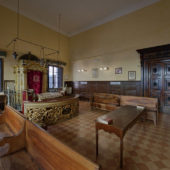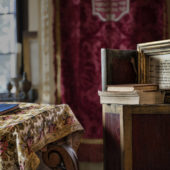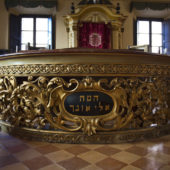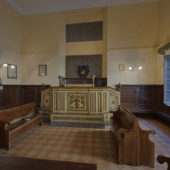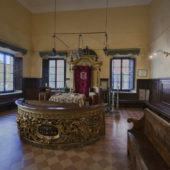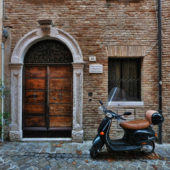The bipolar floorplan, where the Heikhal and bimah are located opposite each other, is typical of Italian synagogues except in the Piedmont.
Senigallia is in the Le Marche region of northern Italy where Jewish people have been living for over 1000 years. Land records prove Jews as owners of vineyards and olive trees in the area since 967 AD. There was a sizable Jewish community in Senigallia by the 1300s, due to the town’s port and lucrative business opportunities. In approximately the 14th century, Senigallia saw its first Jewish banker. After the expulsion of Jews from Spain in 1492 and Portugal in 1497, waves of Sephardic (Spanish) Jews began arriving in Italy, many of whom settled in the port cities, including Senigallia. Jews from the south of Italy and Sicily, who had previously lived in the Kingdom of Naples, also began immigrating to the coastal towns.
As the result of Church pressure, in the second half of the 16th century anti-Jewish decrees were passed, while Senigallia was under the rule of the Della Rovere family. In 1631, rule of the town came directly under the papacy. With the rest of the duchy of Urbino, a ghetto was established in 1634, forcing the 40 Jewish families of Senigallia to live within. Further laws prohibited Jews from owning real estate and they were only permitted to purchase secondhand clothing. However, despite the grim circumstances, the community’s generosity of spirit was demonstrated in 1649 when a large sum of money was collected to ransom Polish Jews who had been sold into slavery during the Cossack Wars. During the following 150 years whilst in the ghetto, the Jewish population trebled. By 1789 there were 600 Jews living in the town. In 1799, taking advantage that the French had temporarily withdrawn from occupying the town, villagers sacked the ghetto, killing 13 Jews and temporarily chasing the rest into temporary exile. Consequently, by 1870, Seingallia’s Jewish population had dwindled to 300. During WWII, the persecution of the Jews was individual rather than collective; the Germans and Italian Fascists demanded tributes to allow the Jews to live. Post WWII there were 400 Jews in Senigallia which declined to 30 by 1969.
The Senigallia Synagogue was built in 1634 by Carlo Visioli, on the site of a much older synagogue. The exterior is a nondescript, two-storey brick façade, featuring an arched entranceway, with slim rectangular windows upstairs. There are no distinguishing features to indicate that this is a synagogue; this was to avoid persecution. Inside, the prayer room is designed in a Rensaissance Baroque style. Pale yellow walls are offset by dark wood paneling on the lower portion of the walls and ornately carved dark woodwork and doors leading to the foyer. Large, deeply inset windows line one side wall, which feature dark woodwork and shutters. The interior is bipolar, featuring an apse, a separate elevated space in the rear similar to a theater, extending into the square main sanctuary. The Aron Kodesh and bimah are designed in the Italian Baroque style, unique in their monumental dimensions. The Renaissance and Baroque design resembles the reception rooms of the Palazzi of the nobility. The bimah is at one end, with the Aron Kodesh on the eastern wall. This was commonly seen in Italian synagogues, except in the Piedmont, and most likely originated from ancient times in Eretz Israel. The Aron Kodesh is elegantly carved of wood, featuring columns supporting a graceful entablature, hand-painted in ivory and gilded. A semi-circular, low, gilded wrought iron balustrade is situated in front of the Aron Kodesh. The tivah (reader’s desk), at the opposite end of the prayer room, is surrounded by three hand carved ivory panels with gilt decorations. Benches facing the side walls sit on the Italian medium-sized diamond-shaped red and ivory tiles. The synagogue recently underwent a one-year restoration project.

